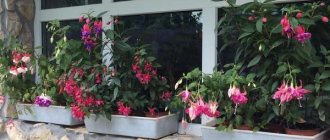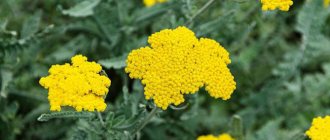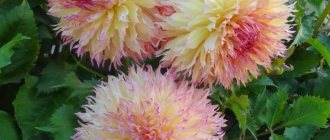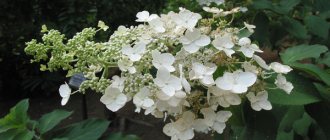Hybrid fuchsia is a popular garden and indoor plant; it does not overwinter in open ground in Russia. In the West, it is often grown as an annual crop; at best, the queen cells are left until spring for propagation. The most versatile is the ampelous fuchsia - it can be planted in a hanging basket, a stationary flowerpot, a flower pot or in a high flowerbed.
Botanical description
Fuchsia is a genus of woody perennials from the fireweed family, which includes about 100 species. Comes from the humid tropics and subtropics of Central and South America, Tahiti, New Zealand.
Appearance
In their homeland, fuchsias are mostly evergreens. In Russia they behave like deciduous perennial trees or shrubs.
The leaves of the crop are collected in whorls of 3-5 pieces or opposite. The length ranges from 1 to 25 cm, but usually within 4-5 cm. The plates are simple, pointed, with a finely toothed edge, elongated oval in shape. The color is green or reddish, there are variegated varieties.
Fuchsia shoots can be relatively flexible and thin, or rigid and erect. The vast majority of cultivars have untrimmed stems that are something in between. Over time, the branches become woody and covered with beige bark.
Bloom
Fuchsia buds form at the tips of the current year's shoots. Flowers consist of two parts, the color of which can be the same, different or differ in shade:
- The calyx is 4 lanceolate, with pointed tips of the lobes, fused at the base into a long tube. After the fuchsia buds have fully bloomed, they are located perpendicular to the petals or slightly cover the base of the corolla, but more often they are bent back to varying degrees. In the latter case, the sepals can be straight, curved, like a bow string, or even slightly twisted. Color: white, all shades of pink or red.
- The fuchsia corolla is often much shorter than the sepals, simple, with 4-5 petals, or terry, looking like a fluffy skirt. The color of the corolla can be white, different shades of pink, red, blue, light blue, violet. Sometimes the petals are painted with contrasting streaks or strokes.
Fuchsias can also be distinguished by their long anthers and pistil protruding beyond the corolla. In ampelous varieties, the buds are attached to a long drooping pedicel and range in size from 1 to 10 cm.
Under natural conditions, the crop is pollinated by hummingbirds. After fertilization, dark purple berries measuring 5-25 mm are set. In most species they are edible and taste like a mixture of citrus and black pepper.
LiveInternetLiveInternet
Monday, October 29, 2012 21:27 + to quote book
| Fuchsia varieties
|
[/td]
Series of messages “Fuchsia”:
Part 1 - TIPS FOR CARE OF FUCHSIA FROM ALLA ZINCHUK Part 2 - THE BEAUTY OF FUCHSIA. DESCRIPTION OF THE VARIETY Part 3 - FUCHSIA: CARE AND REPRODUCTION Part 4 - CARE AND REPRODUCTION OF FUCHSIA FROM M. SHEVICH (Video) ... Part 7 - HOW TO GROW FUCHSIA ON A STEM Part 8 - How to form a beautiful crown in fuchsia? Part 9 - How to grow fuchsias
| Categories: | FLOWERS FLORICULTURE |
Tags:
FLORICULTURE FLOWERS
Cited 17 times Liked by: 3 users
Like share
0
Like
- 3
I liked the post - Quoted
- 0
Saved
- Add to quote book
- 0
Save to links
Liked3
0
Varieties and varieties
Official sources write that there are more than 2000 fuchsia cultivars. Fans claim that there are from 16 to 22 thousand of them in catalogs. It is impossible to determine the exact quantity without a unified database.
One of the most controversial topics is what variety fuchsia belongs to:
- bush (upright) with rigid, erect shoots;
- semi-ampeloid (lax variety) – first grows upward, droops with age;
- hanging (trailer, pendula) - with thin hanging branches.
There are very few varieties that clearly show the characteristics of the first or third group in any conditions. The majority belongs to the second.
Semi-ampeloid fuchsias can grow strong straight or flexible thin shoots, depending on cultivation and care at home. Whether the bush will be ampelous is influenced by lighting, pruning, and fertilizing.
Experienced gardeners skillfully use this and form plants at their own discretion.
There are ampelous fuchsias with barely enough shoots to cover the container, or with very long stems.
Kirsus Spangles
Circus Spangles is an American large-flowered variety from 1990 with white sepals slightly touched with pink. The skirt is terry, round, the color depends on the growing conditions, it can be raspberry or cherry.
White and red-orange strokes are possible on the petals. The variety is half ampelous.
Bora Bora
Bora Bora - fuchsia of American selection (1966). The sepals are reflexed, white, the corollas are densely double, the skirt is blue, with pale pink large strokes.
Whether the variety will be ampelous depends on its formation.
Marinka
Marinka grows as a bush at a young age. Then the branches begin to bend, the fuchsia turns into an ampelous one.
The flowers are simple, rarely semi-double, the sepals are bright red, the petals are crimson.
Millennium
Millenium is an ampelous variety.
The skirt, depending on the place of planting and care, is very dark burgundy or almost black, the sepals are of a rare purple color.
Blue Angel
Blue Angel is a fuchsia with huge flowers, up to 12 cm.
The sepals are snow-white, the terry skirts are blue. Ampel bush.
Blackie
Fuchsia Blacky is distinguished by crimson sepals bent almost to the peduncle and coal-violet, almost black corollas.
When describing the variety, different sources call it erect or ampelous. The growth pattern depends on how the plant is formed.
Southgate
The name Southgate translates as Southern Gate. Medium-sized soft pink flowers abundantly cover the half-ampeled bush.
The shade of the sepals is slightly darker than that of the terry corollas.
Blue Eaz
Fuchsia Blue Eyes is an ampelous variety with several rows of petals.
The flowers are red-blue, double, large, pink stamens.
Most common varieties
Fuchsia growing and care at home
Many modern varieties are characterized by bright color combinations.
Fuchsia Blue Vale
This is a universal variety; it can be grown either as a bush or as an ampel. The snow-white sepals of double, large flowers have a green tint along the edge. The flower's skirt is fluffy and lavender in color.
Flowering is long lasting and very abundant.
Fuchsia Bella Rosella
The plant has some of the largest flowers (10-12 cm). They are terry, bright, lilac-pink with snow-white stamens and pale pink sepals. Flowering is abundant and long lasting.
Fuchsia variety Bella Rosella has an ampelous and bush form. It is unpretentious and can grow in shade.
Variety Bella Rosella
Fuchsia Blue Angel
Blue Angel variety is an exquisite, memorable fuchsia. The flower size is up to 12 cm in diameter. The corolla (skirt) of the flower is double dark lilac in color, the sepals are white. When fully bloomed, white stamens with pink anthers become a spectacular accent. The bush is semi-ampelous (drooping).
Fuchsia Hollis Beauty
The flowers are large (7-8 cm), double, white sepals, lilac-blue skirt. The bush grows very neatly, has a compact shape, and branches well. The variety tolerates heat and bright sun better than other fuchsias.
The flower is elegant, contrasting, white-green sepals set off the purple-pink skirt. Especially good in full dissolution. Pink elongated stamens set off milky white anthers.
Important ! The growing form is ampelous; the lashes of an adult plant grow up to 60 cm in length.
Fuchsia Blue Ice
The plant was obtained as a result of the starting mutation of the Dark Eyes variety in 1954 in the United States of America. Large, double flowers are distinguished by a characteristic arrangement of petals. They resemble a multi-layered petticoat. The color of the petals is deep lavender, the sepals are light crimson. It is interesting that in plants of this variety, flower petals can vary in color intensity. The variety is undemanding; it is grown in bush and hanging forms. Grows quickly, restrictive pruning is recommended to form a dense crown. Feels good in partial shade.
Fuchsia Bicentennial
Fuchsia ampelous Bicentennial is painted in salmon-orange tones. The characteristic magenta strokes along the edge of the multi-layered skirt create an extraordinary color contrast. The flowers are elongated, rather large, in the form of buds. Light sepals become bright orange over time.
The variety was bred by Californian gardener Ted Pasquesen in 1976 and dedicated to the 200th anniversary of US independence. Paskesen carried out lengthy breeding work to obtain a variety that was resistant to heat and strong winds.
The plant forms a dense, branching crown and blooms profusely.
Variety Blue Mirage
Fuchsia Blue Mirage
The plant can be grown as a semi-mounted plant, in the form of a drooping bush and in hanging containers.
Blue Mirage is a large-flowered variety that blooms with deep purple flowers with snow-white sepals. The length of the shoots of the variety is up to 40 cm. Flowering is early, abundant, and long-lasting. The flowers are double and large.
The leaves are medium in size, the stems become woody quickly, so the variety is easy to grow in standard form. The variety is fast growing and winters well. Suitable for growing by beginning gardeners.
Fuchsia Cecile
The flowers are large, double, and have a bright, unusual combination of shades. The wavy, layered petals are lavender blue and the sepals are dark pink. Fuchsia variety Cecile is grown in bush and hanging form.
Vessel
The unique purple-pink color has become the hallmark of the flower; it is not without reason that one of the first synthetic dyes, fuchsin, received its name.
The ships of the Japanese company ONE (Ocean Network Express), which is engaged in sea container transportation, cannot be confused with others. Their signature color is fuchsia.
Photo 7 Motor ship "Fuchsia"
The no less “glamorous” pleasure catamaran “Fuchsia” plies along the Moscow River.
Caring for fuchsia is easy. If you create optimal conditions for the plant, elegant lantern flowers will create a bright mood for many years.
Planting at home
Ampelous fuchsia should be planted 2-3 cuttings in one container:
- Drainage is placed in the pot, the substrate is filled, holes are made according to the shape and size of the root system of young plants.
- Rooted shoots or grown seedlings are taken out of the cups and planted without deepening the central stem.
- Watered.
- If the fuchsia is weak or the root is poorly developed, cover it with a glass cap or cellophane.
- Place in a slightly shaded place.
Strong plants with a powerful root system only need protection from bright sun for 2-3 days and regular spraying of the crown.
Soil requirements
Ampelous fuchsia loves soil with a slightly acidic reaction. It should be structured, loose, and allow water and air to pass through well until the next transplant.
You can use a ready-made substrate for violets or geraniums. Many gardeners who practice intensive care and do not forget about fertilizing grow fuchsias, including hanging ones, in a mixture of peat and coconut fiber. The last component is needed so that in case of accidental drying, you do not place the pot in a bucket of water - peat tends to clump together, dry peat does not absorb liquid well, and coconut fiber absorbs it instantly.
If the owners prefer soil substrates, you can mix equal shares:
- turf soil;
- rotted leaves;
- humus;
- sand;
- sour peat.
Choosing a pot
It is better to grow ampelous fuchsias in ordinary containers. And then put them in a flower pot or hanging basket and take them outside to the balcony.
The container should be proportional to the root, quite close, but containing at least 1 liter of substrate per adult bush. Flowering will begin only when the adventitious shoots entwine the clump.
You can hear the objection that ampelous fuchsia perfectly forms buds in large flowerpots. But not one, but several plants are planted there at once, otherwise it is difficult to obtain a lush, beautiful bush, especially with cascading ampelous varieties.
It is better to take a plastic pot for fuchsia, with several large holes; be sure to place drainage at the bottom. It is needed:
- so that excess moisture does not stagnate in the root area;
- to improve aeration, which is no less important.
The design of a flowerpot or hanging basket is not particularly important. If you care for the ampelous fuchsia correctly, it will cover the walls with flowering vines.
Features of care at home and outdoors
The general rules are mostly the same, although there are differences. Despite the fact that fuchsia comes from the tropics or subtropics, growing the flower in southern gardens is a big problem due to the heat, whiteflies, and overheating of the root system.
Selecting a location
Ampelous fuchsia loves fresh air, but indoors, thanks to air conditioning, it is easier to control the temperature. The plant prefers very moderate temperatures, no more than 20-24° C.
Lighting needs to be intense, bright, but without direct midday rays:
- on the southern window sill protection in the form of a light curtain is required;
- in open ground - planting next to a fence, buildings or larger plants that cover the hanging fuchsia in the middle of the day.
The culture tolerates light partial shade; some cultivars can bloom in poor light, but not in deep shade. In flowerpots, bushes can be placed under a canopy or attached to the branches of a tree with an openwork crown.
Ampelous fuchsias are not planted in flat flower beds - when they come into contact with the ground, the long shoots begin to rot. But they can be placed on tall or terraced flower beds, or in stationary flowerpots.
Watering
Regular irrigation is needed, some sources recommend that the soil be constantly moist, others advise drying it out by a few millimeters. In summer, fuchsia may require daily watering. In flower beds, the soil is mulched with peat or bark to retain moisture; in pots, with sphagnum.
In cool weather and before the dormant period, watering is reduced.
Air humidity needs to be high. In hot weather, the bushes are sprayed several times a day, trying not to get it on the flowers.
Feeding
In the spring, to resume the growing season, grow new shoots and leaves, ampelous fuchsia needs nitrogen; during flowering, phosphorus, potassium plus microelements. The plant especially suffers from magnesium deficiency.
Every 2 weeks in the middle of the season, use complex mineral fertilizers for flowers with the same content of macroelements, for example, 10:10:10 or 20:20:20. Long-acting fertilizers can be used in potted crops.
From the end of summer, nitrogen is eliminated. Feed with phosphorus and potassium preparations.
Formation
Ampelous fuchsia blooms on the tops of the current year's shoots, but only a branched bush will be beautiful. You will have to sacrifice early flowering.
The following algorithm is suitable for young or adult plants, barely rooted cuttings:
- Branches that have grown a little after winter are pinched over 2-3 pairs of leaves.
- The same is done with all the side shoots until the bush takes on a beautiful lush shape.
Depending on the variety and care, 6-12 weeks will pass from the time of the last pinching to the flowering of the ampelous fuchsia.
At the peak of decorativeness, faded corollas and yellowed leaves are removed, and elongated thin shoots are shortened. In case of accidental pollination, which happens extremely rarely, it is better to remove the fruits - nothing worthwhile will grow if you collect the seeds.
At the end of the season, after the leaves of the ampelous fuchsia begin to fly off, the bush needs to be pruned. In hanging varieties, the shoots are shortened by about a third.
Transfer
Transshipment is allowed without disturbing the earthen coma of a flowering plant, although it is better to do this annually in the spring. The operation cannot be performed:
- during the dormant period, when some of the roots die off, life processes are suspended;
- at high temperatures – the crop does not tolerate heat well.
If you are going to plant ampelous fuchsia in open ground, do it after the ground has warmed up to 15° C. The above-ground part of most species and varieties tolerates a short-term decrease to 0° C, holds well at 5° C, but the root does not work, the buds may fall off , even leaves.
Wintering
In potted crops, reduce watering. Bushes are dug out from open ground after the leaves begin to fall, but the thermometer should not cross the zero mark even at night.
The ampelous fuchsias are trimmed by 1/3. Pick off the remaining leaves. Put away for storage.
Wintering on a northern windowsill is only suitable for young plants grown this season from cuttings or seeds. They should remain with the leaves unless they fall off on their own.
The rest of the fuchsias are sent to a frost-free basement, on a glazed balcony. Temperature:
- should not exceed 12° C;
- it is better if it ranges from 6 to 10 ° C;
- permissible minimum – plus 2° C;
- A short-term decrease to 0° C will not cause significant harm.
Selection of location and conditions of detention
Growing and caring for unpretentious fuchsia at home usually does not cause difficulties even for novice gardeners. This unpretentious flower reproduces well by cuttings, quickly grows green mass, and blooms even in partial shade and shade.
However, to obtain large and bright flowers, it is necessary to comply with certain requirements when planting, watering and fertilizing a plant or a spreading ampel standing on a windowsill.
Lighting and location
The location of the pot should be chosen when planting - rearranging the flower can shed its buds and flowers, so moving it is not recommended.
A well-lit place without direct sunlight, with light shading in the heat, is suitable for growing. The best option for a house is an eastern and southwestern window sill. In the shade of a north window, the plant will grow a thick green mass, but it will bloom sparingly.
Room temperature
Fuchsia prefers to grow in moderate warmth, at temperatures from spring to autumn of 18-22°C. If the room is very hot in summer, the leaves and stems will dry out, which will negatively affect the decorative appearance. During the winter dormancy period, the temperature is reduced to 10-16°C, taking the pot to a glazed loggia, if available.
It is important to know. In summer, pots with fuchsias can be taken out into the garden, onto an open balcony, bushes can be planted in flower beds, hanging flower pots, and boxes. However, from September, when the temperature drops to 16°C, the plants need to be brought home again.
Air and humidity
Humid air (50-60% humidity) benefits the flower, so the leaves are regularly sprayed, and sometimes in the summer the pots are placed outside in the rain. If the air in the room is dry, this will increase the risk of infection by various pests and diseases.
For spraying and sprinkling, use only warm water at room temperature, preferably standing for about a day. The procedure is carried out in the morning or evening hours. Do not allow the soil to become waterlogged; this can cause root rot.
Soil and pot
To grow seedlings, small plastic pots with a diameter of 9-10 cm are used. In order for the plant to grow well, grow leaves and form buds, the root system must first occupy the entire volume of the container. Only when the size of the flower increases is it transplanted into a larger pot.
For planting, use a purchased soil mixture for fuchsias or other flowering crops, or prepare the soil yourself. To do this, mix peat, compost, coarse sand and leaf humus in equal parts, adding a little compost flour for more luxuriant flowering. A drainage layer of expanded clay must be poured onto the bottom of the container; the pot is taken with holes in the bottom to drain excess water after watering.
Reproduction methods
Seed propagation is possible only when purchasing planting material in a store. But with a fairly complex process, the result usually does not correspond to the varietal description or the picture on the pack.
To collect your own seeds, you need to carry out hand pollination, since hummingbirds do not live in Russia. But from the seedlings something unattractive will grow.
Fuchsia does not reproduce by leaves.
To propagate the crop, root the tops of shoots 5-8 cm long with 2-3 pairs of leaves. One node should be in a light substrate or water, the other above the surface. The lower leaves are removed, too large ones are shortened by half.
Germination of cuttings is carried out:
- under film or glass cover;
- at high humidity;
- temperature close to 20° C;
- diffused light is needed.
As the roots grow, the fuchsia is replanted several times a season. Place 2-3 pieces in a permanent wide container so that the ampelous bush is thick and beautiful.











